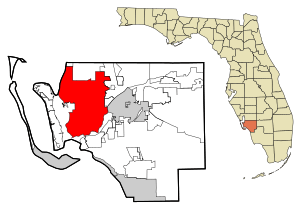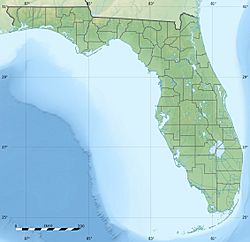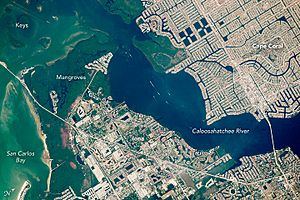Cape Coral, Florida facts for kids
Quick facts for kids
Cape Coral, Florida
|
|||
|---|---|---|---|

Cape Coral from the air, looking southwest
|
|||
|
|||
| Nickname(s):
Venice of America
|
|||

Location in Lee County and the state of Florida
|
|||
| Country | |||
| State | |||
| County | Lee | ||
| Founded | 1957 | ||
| Incorporated | August 18, 1970 | ||
| Government | |||
| • Type | Council-Manager | ||
| Area | |||
| • City | 119.41 sq mi (309.26 km2) | ||
| • Land | 106.03 sq mi (274.61 km2) | ||
| • Water | 13.38 sq mi (34.65 km2) 9% | ||
| Elevation | 3 ft (0.9 m) | ||
| Population
(2020)
|
|||
| • City | 194,016 | ||
| • Estimate
(2022)
|
216,922 | ||
| • Rank | US: 98th | ||
| • Density | 1,829.84/sq mi (706.51/km2) | ||
| • Urban | 599,242 (US: 71st) | ||
| • Urban density | 1,806.0/sq mi (697.3/km2) | ||
| • Metro | 760,822 (US: 77th) | ||
| Time zone | UTC−05:00 (EST) | ||
| • Summer (DST) | UTC−04:00 (EDT) | ||
| ZIP Codes |
33904, 33909, 33914, 33990, 33991, 33993
|
||
| Area code(s) | 239 | ||
| FIPS code | 12-10275 | ||
| GNIS feature ID | 0279997 | ||
| Website | www.capecoral.net | ||
Cape Coral is a city in Lee County, Florida, United States. It is located on the Gulf of Mexico. The city was started in 1957. By 2020, its population grew to over 194,000 people. This makes it the ninth-largest city in Florida.
Cape Coral is very big, covering about 120 square miles. It is the largest city between Tampa and Miami in both size and population. It is also the main city in the Cape Coral-Fort Myers, Florida Metropolitan Statistical Area. A special thing about Cape Coral is its many waterways. It has over 400 miles of canals, which is more than any other city on Earth!
Contents
History of Cape Coral
The first people to live around the Cape Coral area were the Calusa tribe. After Florida became a state in 1845, pioneers began to settle and buy land here.
Cape Coral's modern story began in 1957. Two brothers, Leonard and Jack Rosen, flew over a piece of land called Redfish Point. This land was near Fort Myers. The brothers were real estate developers. They bought about 103 square miles of land with some partners.
In 1958, they started building the city as a planned community. They formed a company called Gulf American Land Corporation (GALC). This company helped sell the land. They dug many Canals and built streets, houses, and businesses. Cape Coral was promoted a lot, even with celebrities. The first building was the Rosens' sales office. The first four homes were finished in May 1958.
Development kept going in the early 1960s. By 1963, about 2,850 people lived there. Many buildings were built, and miles of roads and canals were finished. A public yacht club, a golf course, a medical clinic, and a shopping center opened. A big step for Cape Coral was building the Cape Coral Bridge. This bridge is 3,400 feet long and opened in 1964. It made it much easier to get to Fort Myers.
The city officially became a city on August 18, 1970. Its population grew quickly for many years. In September 2022, Hurricane Ian caused a lot of damage to Cape Coral.
Geography of Cape Coral
Cape Coral covers about 120 square miles. About 110 square miles are land, and 9 square miles are water. Cape Coral is a large peninsula, which means it's mostly surrounded by water. The Caloosahatchee River borders it to the south and east. Matlacha Pass is to the west.
Fort Myers is across the Caloosahatchee River. Matlacha and Pine Island are across Matlacha Pass. Matlacha Pass is home to a special wildlife area called Matlacha Pass National Wildlife Refuge.
Animals and Plants in Cape Coral
The area is home to many animals. You can find waterfowl, wading birds, and songbirds. There are also gopher tortoises, dolphins, and reptiles. Rotary Park has wading birds, raptors, butterflies, and foxes. You can see exotic birds and native fish at Lake Kennedy. You can also watch West Indian manatees at Sirenia Vista Park. Cape Coral has the largest number of burrowing owls in Florida.
Invading Species in Cape Coral
Cape Coral has three types of animals that are not native to the area. These are the green iguana, the spiny-tailed iguana, and the Nile monitor. The iguanas are common in southern Florida and usually don't cause problems. However, the Nile monitor is a large lizard, about 3 to 7 feet long. It moves and swims fast and eats fish, birds, and small mammals. The city's many waterways make it hard to catch these monitors.
Climate in Cape Coral
Cape Coral has a warm climate. It's like a tropical savanna, almost a tropical monsoon climate. The city gets about 355 sunny days each year. It rains on about 145 days a year. The wet season is from May to October. It's hot and humid with heavy rain showers. The dry season is from November to April. It's pleasantly warm with less rain.
The city gets about 56 inches of rain every year. Most of this rain falls from June to September. In summer, afternoon thunderstorms are strong but short. The city is also affected by hurricane season. This season officially runs from June 1 to November.
| Climate data for Cape Coral, FL | |||||||||||||
|---|---|---|---|---|---|---|---|---|---|---|---|---|---|
| Month | Jan | Feb | Mar | Apr | May | Jun | Jul | Aug | Sep | Oct | Nov | Dec | Year |
| Record high °F (°C) | 88 (31) |
91 (33) |
93 (34) |
96 (36) |
99 (37) |
103 (39) |
98 (37) |
98 (37) |
96 (36) |
95 (35) |
95 (35) |
90 (32) |
103 (39) |
| Mean daily maximum °F (°C) | 75 (24) |
76 (24) |
80 (27) |
85 (29) |
89 (32) |
91 (33) |
91 (33) |
92 (33) |
90 (32) |
86 (30) |
80 (27) |
76 (24) |
84 (29) |
| Daily mean °F (°C) | 64 (18) |
65 (18) |
70 (21) |
73 (23) |
78 (26) |
82 (28) |
83 (28) |
83 (28) |
82 (28) |
77 (25) |
71 (22) |
66 (19) |
75 (24) |
| Mean daily minimum °F (°C) | 53 (12) |
54 (12) |
58 (14) |
62 (17) |
67 (19) |
73 (23) |
74 (23) |
75 (24) |
74 (23) |
69 (21) |
60 (16) |
55 (13) |
65 (18) |
| Record low °F (°C) | 28 (−2) |
32 (0) |
33 (1) |
39 (4) |
52 (11) |
60 (16) |
66 (19) |
67 (19) |
67 (19) |
48 (9) |
34 (1) |
26 (−3) |
26 (−3) |
| Average precipitation inches (mm) | 1.7 (43) |
2.1 (53) |
2.7 (69) |
1.3 (33) |
3.7 (94) |
9 (230) |
8.5 (220) |
9 (230) |
8.3 (210) |
3.5 (89) |
1.5 (38) |
1.5 (38) |
52.8 (1,340) |
| Average precipitation days (≥ 0.01 in) | 7 | 8 | 7 | 6 | 10 | 18 | 22 | 22 | 20 | 11 | 7 | 7 | 145 |
| Source: Bestplaces.net | |||||||||||||
People of Cape Coral (Demographics)
| Historical population | |||
|---|---|---|---|
| Census | Pop. | %± | |
| 1970 | 10,193 | — | |
| 1980 | 32,103 | 215.0% | |
| 1990 | 74,991 | 133.6% | |
| 2000 | 102,286 | 36.4% | |
| 2010 | 154,309 | 50.9% | |
| 2020 | 194,016 | 25.7% | |
| 2022 (est.) | 216,992 | 40.6% | |
| Sources: | |||
The city's population has grown a lot over the years. In 2020, there were 194,016 people living in Cape Coral. There were about 69,912 households and 48,359 families.
As of 2021, Cape Coral is the eighth largest city in Florida by population. Many residents are between 18 and 64 years old. There are more people under 25 than over 65. The number of young adults (18-24) is growing faster here than in the rest of Florida or the United States.
In 2020, the average income for a household in the city was $65,282. About 9.9% of the people live below the poverty line.
In 2000, most residents (87.18%) spoke only English at home. Other languages spoken included Spanish (7.61%), German (1.70%), and Italian (1.20%).
| Race / Ethnicity (NH = Non-Hispanic) | Pop 2000 | Pop 2010 | Pop 2020 | % 2000 | % 2010 | % 2020 |
|---|---|---|---|---|---|---|
| White (NH) | 89,535 | 113,476 | 129,017 | 87.53% | 73.54% | 66.50% |
| Black or African American (NH) | 1,831 | 5,679 | 7,597 | 1.79% | 3.68% | 3.92% |
| Native American or Alaska Native (NH) | 227 | 356 | 350 | 0.22% | 0.23% | 0.18% |
| Asian (NH) | 927 | 2,272 | 3,207 | 0.91% | 1.47% | 1.65% |
| Pacific Islander or Native Hawaiian (NH) | 48 | 60 | 87 | 0.05% | 0.04% | 0.04% |
| Some other race (NH) | 152 | 295 | 958 | 0.15% | 0.19% | 0.49% |
| Two or more races or Multiracial (NH) | 1,045 | 2,150 | 6,649 | 1.02% | 1.39% | 3.43% |
| Hispanic or Latino (any race) | 8,521 | 30,017 | 46,151 | 8.33% | 19.45% | 23.79% |
| Total | 102,286 | 154,309 | 194,016 | 100.00% | 100.00% | 100.00% |
Economy of Cape Coral
Cape Coral's economy mainly focuses on healthcare, shopping, and real estate. The city works to bring new businesses to the area. In 2016, the top five employers were Lee Memorial Hospital, Lee County School System, Publix Supermarkets, the City of Cape Coral, and Walmart.
Cape Coral Hospital provides medical care. For serious injuries, people go to Gulf Coast Medical Center in Fort Myers. In 2012, the Lee County VA Healthcare Center opened. It offers many medical services for veterans. Lee Health plans to add more healthcare services in the future. This includes a new hospital by 2030 and expanding the ICU at Cape Coral Hospital.
Lee Health is also working with Florida State University. They are creating a program for doctors at Cape Coral Hospital. A new outpatient center will open near Downtown Cape Coral.
In 2021, Bayfront Health opened a new Emergency Room and Urgent Care center. In 2022, HCA Florida also opened a 24/7 Emergency Room. Encompass Health opened a rehabilitation hospital in 2022 as well.
Fun Things to Do in Cape Coral
Cape Coral has many fun places and activities.
- Gator Mike's Family Fun Park opened in 1992. It used to be called Mike Greenwell's Bat-A-Ball & Family Fun Park. It has mini-golf, Go-Karts, zip lining, and bungee jumping.
- The city has two libraries that are part of the Lee County Library System.
- You can visit SunSplash Water Park for water fun.
- There's a sandy beach and fishing pier on the Caloosahatchee River. It's at the public Yacht Basin and Club.
- The city has over 30 parks. These parks have playgrounds, open fields, and walking paths. Some also have workout equipment and golf courses.
- You can see the largest group of burrowing owls in Florida here.
- Explore nature at Four Mile Cove Ecological Preserve. It has an elevated nature trail through Florida mangroves.
Education in Cape Coral
Cape Coral has many public and private schools. They are known for their high standards. The city is part of the Lee County School District. This district runs 8 elementary, 6 middle, and 5 high schools in Cape Coral.
There are four public high schools:
- Cape Coral High School (built in the late 1970s)
- Mariner High School (opened in 1987)
- Ida S. Baker High School (opened in 2005)
- Island Coast High School (opened in 2008)
Cape Coral also has its own charter school system called Oasis Charter Schools. This system includes two elementary schools, Oasis Middle School, and Oasis High School. These schools use special learning programs. Since they are public, there is no tuition. Only children who live in Cape Coral can attend these charter schools.
The main campus of Florida SouthWestern State College is near Cape Coral in Fort Myers. This college offers associate and bachelor's degrees. It also has training for jobs in healthcare, computers, and business. Over 16,000 students attended in 2009.
Florida Gulf Coast University (FGCU) is another college nearby. It opened in 1997 and has over 12,000 students. FGCU has a satellite location in Cape Coral. This allows Cape Coral students to take more classes closer to home. Other colleges in the area include Hodges University and Rasmussen College.
Cape Coral Technical College offers training after high school. It is run by the Lee County public school system. It provides training in medical, computer, and food-related jobs.
How Cape Coral Works (Infrastructure)
Canals in Cape Coral
Cape Coral has over 400 miles of canals. Most of these canals can be used by boats. Some even connect to the Gulf of Mexico. The large canal system has changed the local environment and tides. It allows many residents to live on the water. They can reach the Gulf of Mexico through the Caloosahatchee River and Matlacha Pass. The city has three public places to launch boats. The Gulf of Mexico offers access to small islands and great fishing spots.
Roads and Bridges in Cape Coral
Interstate 75 is about 10 miles from Cape Coral. It connects to Tampa to the north and Miami to the southeast. U.S. Highway 41 is also close by. You can get to U.S. 41 and I-75 from State Route 78 (Pine Island Road).
Inside the city, there are about 1100 miles of roads. North-south roads are usually spaced every one or two miles. Most of them have at least four lanes.
Cape Coral connects to the south side of the Caloosahatchee River with two bridges. The Cape Coral Bridge is 3,400 feet long. It links Cape Coral Parkway to College Parkway in McGregor. The Midpoint Memorial Bridge connects Veterans Parkway to Colonial Boulevard in Fort Myers.
In 2026, there are plans to build a new part for the Cape Coral Bridge. This new part will be for westbound traffic. The project will cost $185 million. It will include a new pedestrian bridge and expand the bridge to 6 lanes.
Getting Around Cape Coral (Transportation)
Public transportation in Cape Coral is provided by LeeTran. LeeTran has 18 bus routes, and six of them are within Cape Coral.
Cape Coral is about 14 miles from Southwest Florida International Airport (RSW). This airport serves almost 10 million passengers each year. Many airlines fly to and from RSW. Cape Coral is also near Page Field, a smaller airport in Fort Myers. Punta Gorda Airport (PGD) is about 10 miles north of Cape Coral.
City Services (Utilities)
In 1977, Cape Coral was the first city in the United States to use a special process called reverse osmosis on a large scale. This process cleans water. By 1985, the city had the world's largest plant using this method.
The city also collects and cleans sewage water. This cleaned water is called "rescued water." It is sent through a separate pipe system and used for watering plants. This helps save fresh water.
Cape Coral was also one of the first cities in Florida to use a new wireless channel. This channel is for public safety use, like for police and fire departments.
Famous People from Cape Coral
- Nate Allen, NFL player
- Pat Burke, NBA player
- Stacy Carter, professional wrestler
- Dustin Diamond, actor
- Earnest Graham, NFL player
- Mike Greenwell, MLB player
- Jessica Holmes, TV host
- Hilary Hemingway, author
- Jeff Lindsay, author
- Shane McClanahan, MLB player
- Joseph Mercola, physician
- Seth Petruzelli, mixed martial arts fighter
- Niko Price, mixed martial arts fighter
- Jason Smith, Olympic curler
- Greg Spires, NFL player
- Angela Watson, actress
- Michael Wendler, German singer
- Karey Lee Woolsey, singer-songwriter
- Mike Zunino, MLB player
- Tony Bruno, Radio personality
Images for kids
See also
 In Spanish: Cabo Coral (Florida) para niños
In Spanish: Cabo Coral (Florida) para niños













